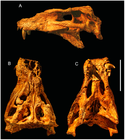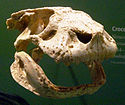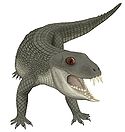- Notosuchia
-
Notosuchia
Temporal range: Early Cretaceous – Late Cretaceous, 110–65 Ma
Anatosuchus Scientific classification 
Kingdom: Animalia Phylum: Chordata Class: Reptilia Superorder: Crocodylomorpha clade: Metasuchia Suborder: †Notosuchia
Gasparini, 1971Families - †Notosuchidae
- †Chimaerasuchidae
- †Comahuesuchidae
- †Candidodontidae
- †Sphagesauridae
- †Baurusuchidae
Notosuchia is a suborder of primarily Gondwanan mesoeucrocodylian crocodylomorphs that lived during the Cretaceous. Fossils have been found from South America, Africa, and Asia. Notosuchia was a clade of terrestrial crocodilians that evolved a range of feeding behaviours, including herbivory (Chimaerasuchus), omnivory (Simosuchus), and terrestrial hypercarnivory (Baurusuchus). It included many members with highly derived traits unusual for crocodylomorphs, including mammal-like teeth, flexible bands of shield-like body armor similar to those of armadillos (Armadillosuchus), and possibly fleshy cheeks and pig-like snouts (Notosuchus). The suborder was first named in 1971 by Zulma Gasparini and has since undergone many phylogenetic revisions.[1]
Contents
Description
Notosuchians were generally small, with slender bodies and erect limbs. The most distinctive characteristics are usually seen in the skull. Notosuchian skulls are generally short and deep. While most are relatively narrow, some are very broad. Simosuchus has a broadened skull and jaw that resembles a pug, while Anatosuchus has a broad, flat snout like that of a duck.
The teeth vary greatly between different genera. Many have heterodont dentitions that vary in shape across the jaw. Often, there are large canine-like teeth protruding from the front of the mouth and broader molar-like teeth in the back. Some genera, such as Yacarerani and Pakasuchus, have extremely mammal-like teeth. Their molars are complex and multicuspid, and are able to occlude or fit with one another. Some forms such as Malawisuchus had jaw joints that enabled them to move the jaw back and forth in a shearing motion rather than just up and down.
A derived group of notosuchians, the baurusuchids, differ considerably from other forms. They are very large in comparison to other notosuchians and are exclusively carnivorous. Baurusuchids have deep skulls and prominent canine-like teeth.
Classification
Taxonomy
Genera
The evolutionary interrelationships of Notosuchia are in flux, but the following genera are generally considered notosuchians:
Genus Age Location Unit Notes Images Turonian - Santonian Adamantina Formation
A carnivore with a very short, high skull and large eye sockets
Aptian - Albian Tegama Group
A small notosuchian under 1 metre (3.3 ft) long with a duck-like snout
Araripesuchus
Albian - Maastrichtian Maevarano Formation
Echkar Formation
Santana Formation
Candeleros FormationFive species are known, the most of any notosuchian

Armadillosuchus
Turonian - Santonian Adamantina Formation
A sphagesaurid with armadillo-like armor shields. 
Turonian Adamantina Formation
A large hypercarnivore 3.5 to 4 metres (11 to 13 ft) in length

Caipirasuchus
Turonian – Santonian Adamantina Formation
Campinasuchus
Turonian – Santonian Adamantina Formation
Candidodon
Albian Itapecuru Formation
Aptian - Albian Wulong Formation
The first notosuchian found with heterodont teeth, thought to be a herbivore
Santonian 
Coniacian – Santonian Bajo de la Carpa Formation
Pichi Picun Leufu FormationEarly Cretaceous A possible burrower that could move its jaw back and forth while eating
Campanian - Maastrichtian Adamantina Formation

Turonian - Santonian Adamantina Formation

Coniacian - Santonian A notosuchian that may have had a pig-like snout

Pakasuchus
Albian A notosuchian with very complex, mammal-like heterodont teeth. 
Pissarrachampsa
Campanian – Maastrichtian Vale do Rio do Peixe Formation

Maastrichtian A broad-snouted omnivore with clove-shaped teeth 
Sphagesaurus
Late Cretaceous Adamantina Formation
An omnivorous notosuchian
Stratiotosuchus
Turonian – Santonian Adamantina Formation
Santonian - Campanian 
Santonian Yacarerani
Turonian - Santonian A notosuchian with rabbit-like incisors found in association with a probable nest 
Phylogeny
Cladograms of Notosuchia
Ortega et al., 2000[2] Notosuchia Sebecus
Itaborai crocodile
Bretesuchus
Pol, 2003[3] Notosuchia Candidodon
Sphagesaurus
Sebecosuchia Bretesuchus
Larsson and Sues, 2007[4] Metasuchia
Taxa previously assigned to NotosuchiaNotosuchia Araripesuchus
Sebecia Sebecidae The clade Notosuchia has undergone many recent phylogenetic revisions. In 2000, Notosuchia was proposed to be one of two groups within the clade Ziphosuchia, the other being Sebecosuchia, which included deep snouted forms such as baurusuchids and sebecids.[2] The definition of Notosuchia by Sereno et al. (2001) is similar to that of Ziphosuchia as it includes within it Sebecosuchia. Pol (2003) also includes Sebecosuchia within Notosuchia.[3] More recently, a phylogenetic analysis by Larsson and Sues (2007) resulted in the naming of a new clade, Sebecia, to include sebecids and peirosaurids.[4] Baurusuchidae was considered to be polyphyletic in this study, with Pabwehshi being a basal member of Sebecia and Baurusuchus being the sister taxon to the clade containing Neosuchia and Sebecia. Thus, Sebecosuchia was no longer within Notosuchia and not considered to be a true clade, while Notosuchia was found to be a basal clade of Metasuchia.
The following cladogram simplified after an analysis of derived notosuchians presented by Fabiano V. Iori and Ismar S. Carvalho in 2011.[5]
Araripesuchus
Yacarerani
Candidodon
Sphagesauridae Sphagesaurus huenei
Caipirasuchus
Armadillosuchus
"Sphagesaurus" montealtensis
Sebecidae
The following cladogram simplified after a comprehensive analysis of notosuchians which focused on Simosuchus clarki presented by Alan H. Turner and Joseph J. W. Sertich in 2010.[6]
Notosuchia Mahajangasuchidae Kaprosuchus
Peirosauridae Peirosaurus
Lomasuchus
Hamadasuchus
"Araripesuchus" wegeneri
"Araripesuchus" tsangatsangana
Araripesuchus buitreraensis
Araripesuchus patagonicus
Araripesuchus gomesii
Ziphosuchia Notosuchidae Sphagesaurus huenei
Sphagesaurus montealtensis
Yacarerani
Armadillosuchus
Sebecosuchia Sebecia
References
- ^ Gasparini, Z. (1971). "Los Notosuchia del Cretácico de América del Sur como un nuevo Infraorden de los Mesosuchia (Crocodilia)". Ameghiniana 8: 83–103.
- ^ a b Ortega, F. Z.; Buscalioni, A. D.; and Calvo, J. O. (2000). "A new species of Araripesuchus (Crocodylomorpha, Mesoeucrocodylia) from the Lower Cretaceous of Patagonia (Argentina)". Journal of Vertebrate Paleontology 20 (1): 57–76. doi:10.1671/0272-4634(2000)020[0057:ANSOAC]2.0.CO;2.
- ^ a b Pol, D. (2003). "New Remains of Sphagesaurus huenei (Crocodylomorpha: Mesoeucrocodylia) from the Late Cretaceous of Brazil". Journal of Vertebrate Paleontology 23 (4): 817–831. doi:10.1671/A1015-7.
- ^ a b Larsson, H. C. E.; and Sues, H.-D. (2007). "Cranial osteology and phylogenetic relationships of Hamadasuchus rebouli (Crocodyliformes: Mesoeucrocodylia) from the Cretaceous of Morocco". Zoological Journal of the Linnean Society 149 (4): 533–567. doi:10.1111/j.1096-3642.2007.00271.x.
- ^ Fabiano V. Iori and Ismar S. Carvalho (2011). "Caipirasuchus paulistanus, a new sphagesaurid (Crocodylomorpha, Mesoeucrocodylia) from the Adamantina Formation (Upper Cretaceous, Turonian–Santonian), Bauru Basin, Brazil". Journal of Vertebrate Paleontology 31 (6): 1255–1264. doi:10.1080/02724634.2011.602777. http://www.tandfonline.com/doi/abs/10.1080/02724634.2011.602777.
- ^ Turner, Alan H.; and Sertich, Joseph J. W. (2010). "Phylogenetic history of Simosuchus clarki (Crocodyliformes: Notosuchia) from the Late Cretaceous of Madagascar". Journal of Vertebrate Paleontology 30 (6, Memoir 10): 177–236. doi:10.1080/02724634.2010.532348.
Thalattosuchia Notosuchia Sebecia Peirosauridae · SebecidaeNeosuchia Atoposauridae · Dyrosauridae · Goniopholididae · Mahajangasuchidae · Paralligatoridae · PholidosauridaeRelated articles Related categories Marine crocodiles · Terrestrial crocodiles · Jurassic crocodylomorphs · Cretaceous crocodylomorphs · Paleogene crocodylomorphs · Neogene crocodylomorphsGenera Adamantinasuchus · Anatosuchus · Araripesuchus · Armadillosuchus · Baurusuchus · Caipirasuchus · Campinasuchus · Candidodon · Chimaerasuchus · Comahuesuchus · Cynodontosuchus · Malawisuchus · Mariliasuchus · Morrinhosuchus · Notosuchus · Pakasuchus · Pissarrachampsa · Simosuchus · Sphagesaurus · Stratiotosuchus · Uruguaysuchus · Wargosuchus · Yacarerani
Families Baurusuchidae · Candidodontidae · Comahuesuchidae · Chimaerasuchidae · Notosuchidae · SphagesauridaeRelated categories Terrestrial crocodiles · Cretaceous crocodylomorphsThis article about a prehistoric archosaur is a stub. You can help Wikipedia by expanding it.

